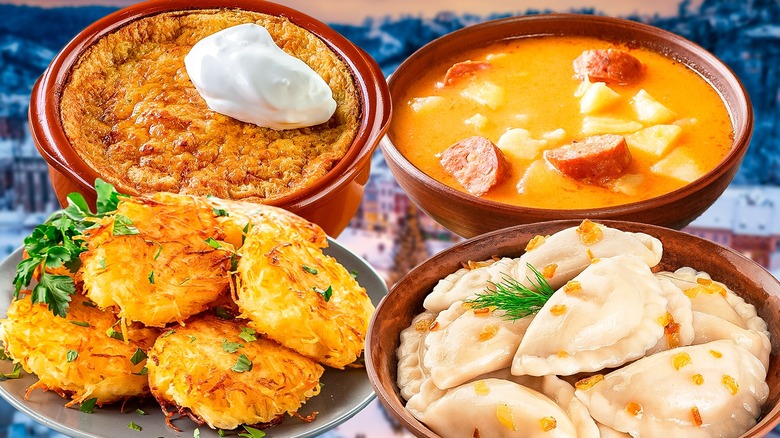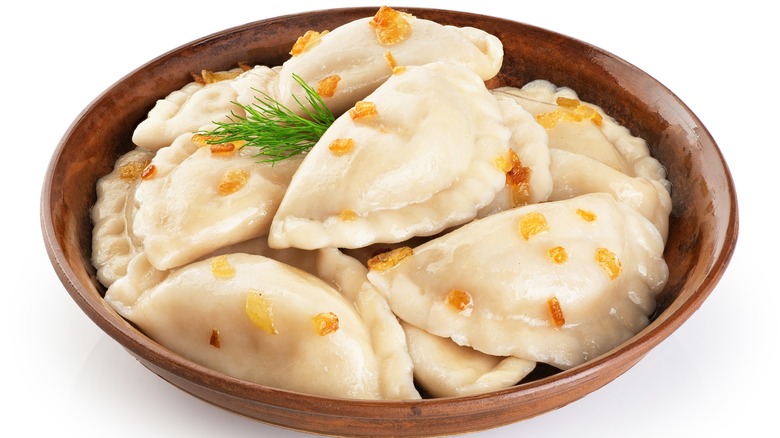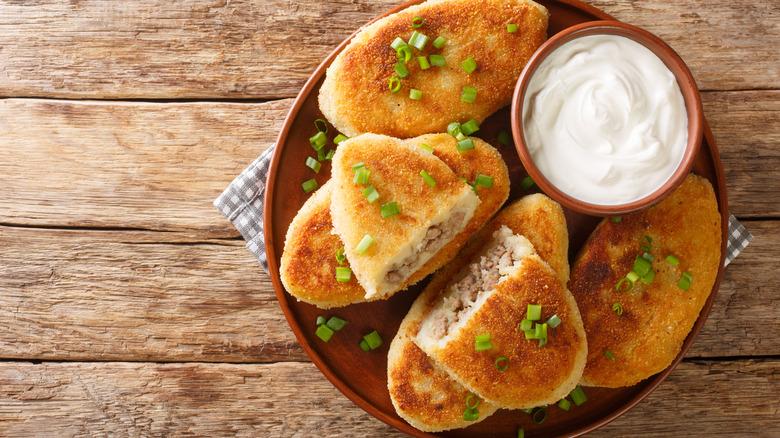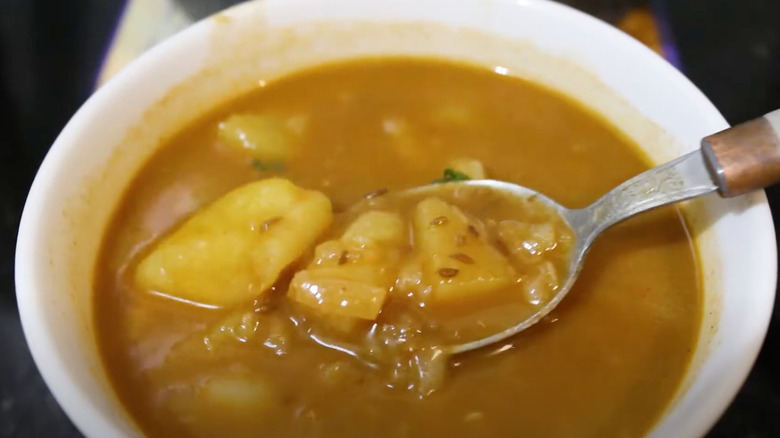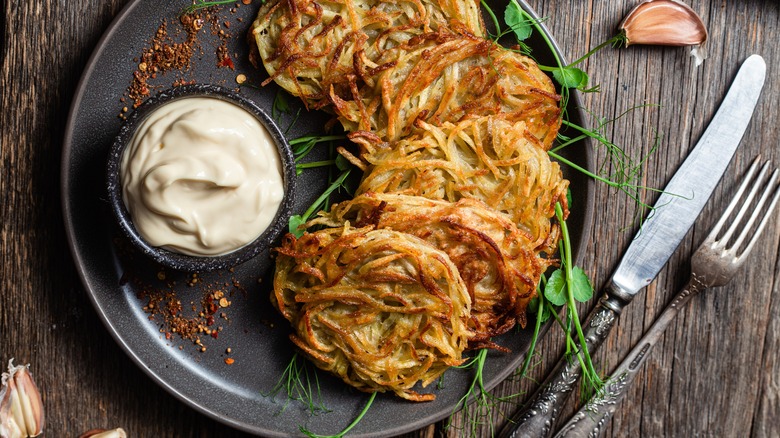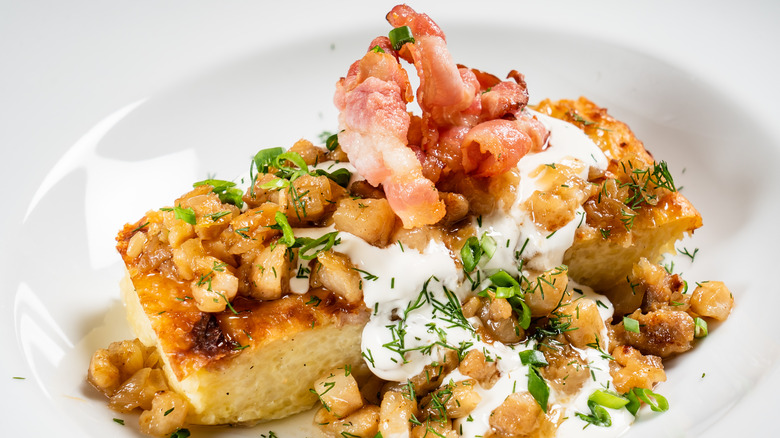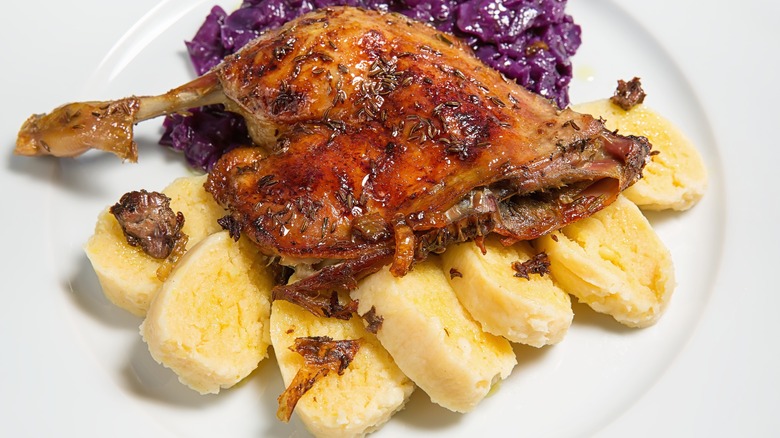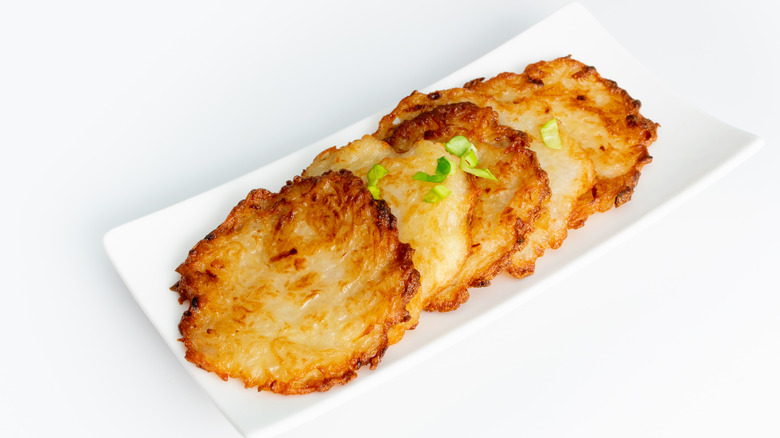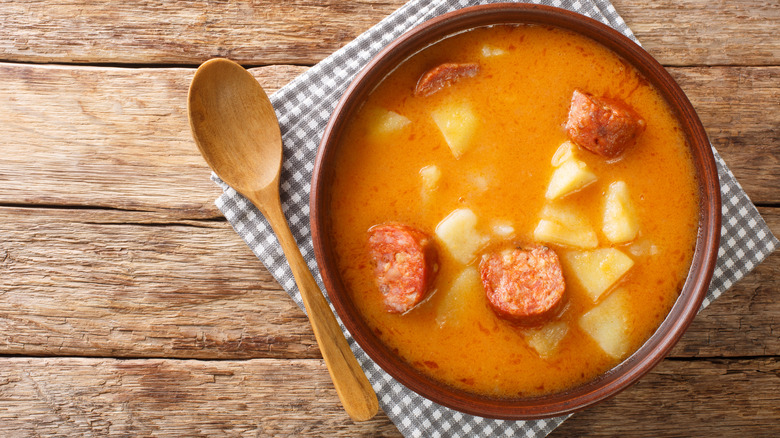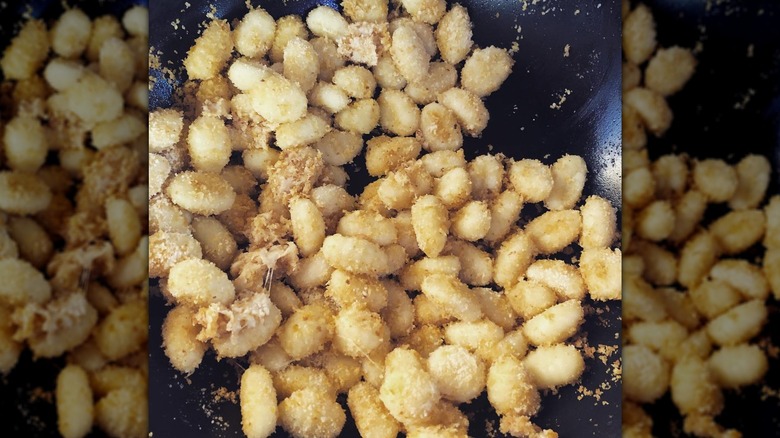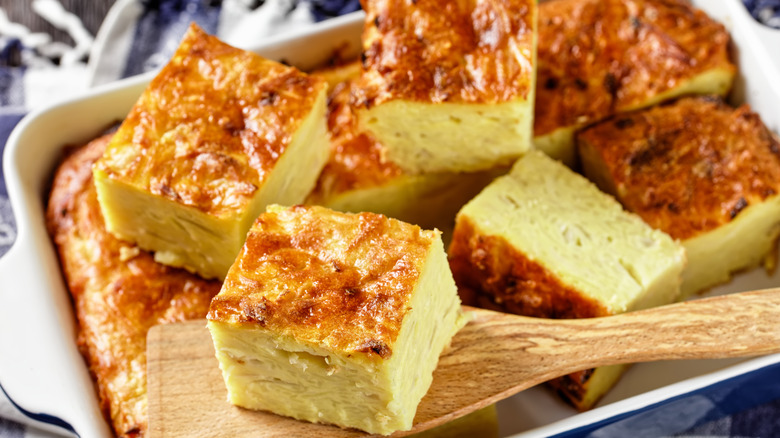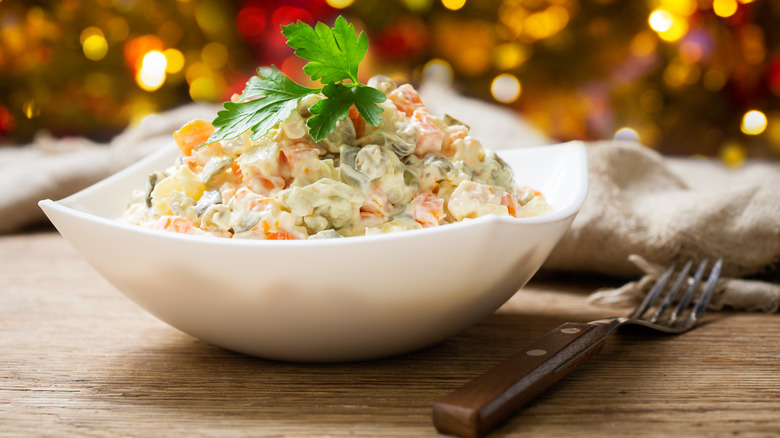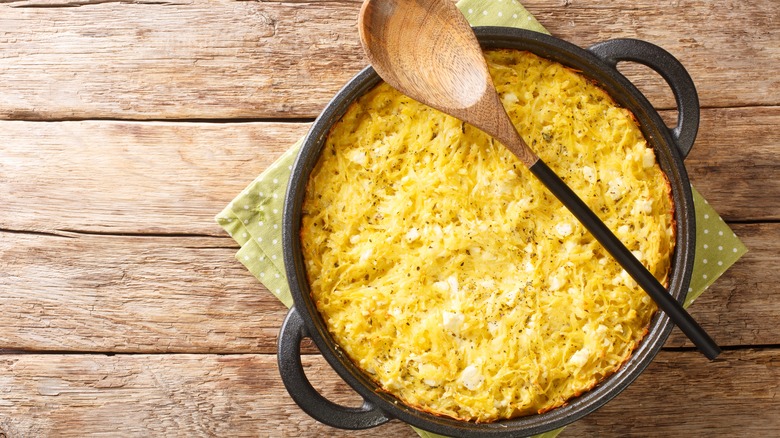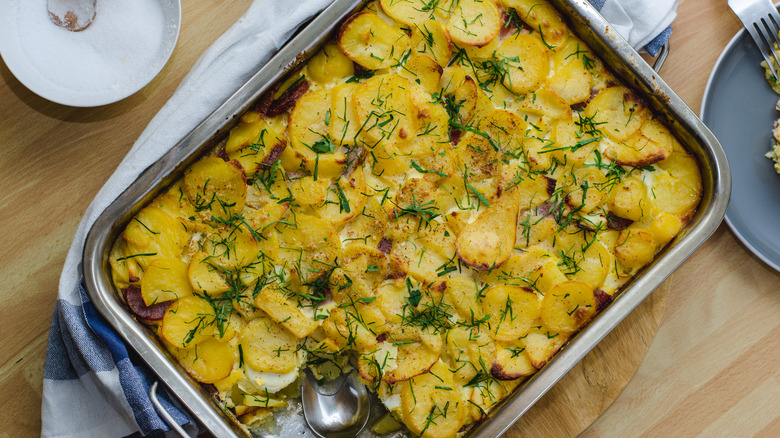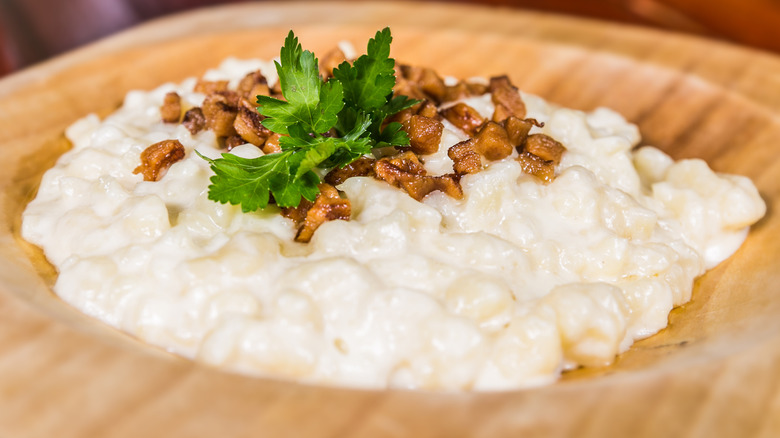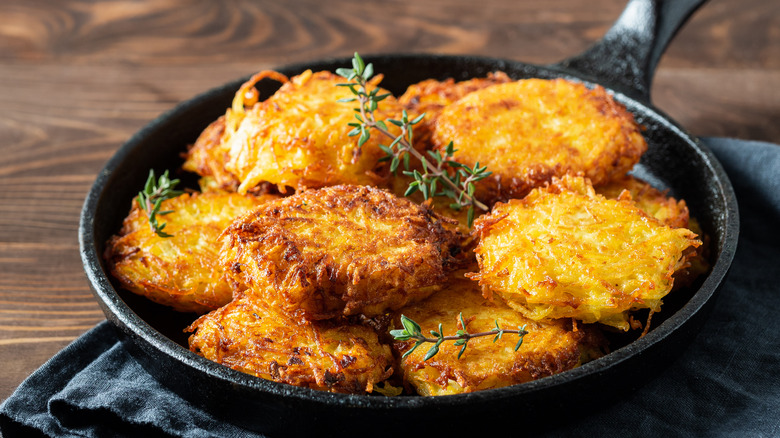15 Eastern European Potato Dishes You Should Try At Least Once
Potatoes were first cultivated in Peru sometime between 8,000 B.C. and 5,000 B.C., but they didn't make their way to Europe until sometime in the mid-1500s. After failed attempts to cultivate the potato in Spain, they finally took hold in the British Isles before spreading to Germany, Prussia, and Poland, in a migration that extended well into the mid-18th century. Despite their relatively recent arrival in Eastern Europe, potatoes are now staples in the region's culinary traditions.
Though each country has its own spin on preparing spuds, it doesn't take much to see the similarities. No matter where you go in Eastern Europe, you're guaranteed to find a healthy serving of pancakes, dumplings, and casseroles all made with potatoes. Though these dishes share a common tuber ingredient, they each possess a distinctive character, shaped by local ingredients, culinary preferences, and time-honored traditions. Let's explore the rich tradition of Eastern European potato dishes, which may inspire you to seek out or create these dishes to experience the unique flavor combinations yourself.
Pierogi
Bigos, also known as hunter's stew in English, might hold the title of Poland's national dish, but pierogies are by far the country's most famous food export. Despite their widespread popularity, the exact origins of these crescent-shaped dumplings remain unclear. Some trace their journey from the Far East, passing through Kievian Rus (modern-day Ukraine) before making their way to Poland in the 13th century. Others contend that Marco Polo introduced the dish from China.
Regardless of the differing origin stories, the first written pierogi recipe appeared in "Compendium Ferculorum, albo Zebranie Potraw" ("A Collection of Dishes"), a Polish cookbook published in 1682 by esteemed chef Stanisław Czerniecki, per the Museum of King Jan III's Palace at Wilanów. The earliest pierogi recipe featured a filling made out of chopped veal kidneys, tallow, greens, and nutmeg. Over the centuries, the recipe continued to transform, reflecting the preferences of each cook. In the 17th and 18th centuries, the upper class dined on pierogies filled with fruit, Asian spices, and sugar, while commoners used pierogies as an opportunity to dress up the simple ingredients available to them, like groat, according to the BBC.
Potatoes didn't become a key ingredient in pierogis until at least the 18th century, but they've quickly become a favorite filling. Nowadays, "pierogi ruskie," meaning "Russian pierogies," a variety made with quark cheese, onions, and potato, is arguably the most popular variety.
Kartofelnye zrazy
The name of this dish, which loosely translates to potato cutlets, comes from "zrazy," the Polish word for "slices" or "cut pieces." Despite its distinctly Polish name, zrazy are also popular in neighboring countries like Ukraine, Lithuania, and Belarus. Although they were initially prepared as seasoned beef patties stuffed with vegetables, potatoes, mushrooms, and eggs, zrazy later incorporated potatoes to create small cakes filled with meat and vegetables.
To prepare them, tender potatoes are mashed with egg and flour to form a dough. The dough is then rolled out into small disks. From there, they're filled with minced meat or sautéed vegetables. Next, the disks are folded into cutlets and coated with bread crumbs or cornmeal, before taking a dip in the frying pan until they turn golden-brown. Like any Eastern European potato dish worth its salt, kartofelnye zrazy is best enjoyed with a generous dollop of sour cream and a sprinkling of fresh dill and chives.
Ćoravi gulaš
If you've ever traveled through Eastern Europe, particularly the Balkans, chances are that you've sampled goulash before. The national dish of Hungary, goulash is a hearty beef and vegetable stew liberally seasoned with paprika. While this rendition of the dish is the most famous, it's far from being the only version. Unbeknownst to many, Hungary's southern neighbor, Croatia, has its own rendition of goulash. It will challenge everything you thought you knew about this soul-warming dish.
Called "ćoravi gulaš," a name that loosely translates to "blind" goulash for its lack of meat, Croatia's version takes a decidedly vegetarian route. It was especially popular during the Croatian War of Independence in the early 1990s, when meat was scarce. Rather than devising entirely new recipes, Croatians modified their traditional goulash by utilizing the ingredients at hand. To prepare it, potatoes, onions, carrots, and peas are simmered in a tomato base seasoned with paprika, parsley, bay leaves, and garlic. Some cooks prefer to leave the base watery, while others add a sprinkling of flour to make it more stew-like. The final product is often accompanied by sour cream, an addition that imparts creamy, tangy notes to the soup.
Draniki
In the realm of potato pancakes, it seems that every country boasts its unique rendition. Ireland takes pride in boxty, Korea presents gamja-jeon, and Sweden showcases raggmunkar — just to name a few. Although less popular on the international stage, Belarus' version, draniki, deserves a second look. Like similar versions from Poland, draniki are made by combining grated potatoes with egg, onion, and cornstarch. Belarusian cooks favor the local bulba potato for its dry, fluffy texture, but a starchy variety like russet is an excellent substitute.
The potato and egg mixture is used to make patties, which are then pan-fried to golden-brown perfection. Salt, pepper, paprika, sweet onion, and garlic can be added to the mixture to liven things up, and the cooked patties can be topped with sour cream for an extra burst of tanginess or applesauce or fruit for a sweeter finish. Draniki are also often served with homemade sausages or machanka, a pork stew.
Potato babka
From dumplings and pancakes to quiches and soups, potatoes can be incorporated into dishes of all shapes and sizes. While we love starch-based meals in all their forms, we'd be lying if we didn't mention our love for potato casseroles. Every country has its version, but in general, they include layers of sliced or diced potatoes interspersed with a creamy sauce, cheese, and herbs. The ingredients list is worth fawning over itself, but the magic truly unfolds during preparation. As the casserole bakes, it develops a tantalizingly crispy crust that perfectly encapsulates the rich, bubbly filling.
Potato babka, a potato casserole popular in Belarus and northeastern Poland (where it's known as babka ziemniaczana), is everything we love about potato casseroles and more. This culinary masterpiece is prepared by combining grated potatoes and onions with salt pork or bacon, egg, flour, sour cream, salt, and pepper before baking. The secret to a perfectly crispy potato babka is to cook the casserole once, then brush the top with leftover meat grease or oil before popping it back into the oven for an extra 10 minutes. To complete the experience, babka is often served with a dollop of sour cream, freshly chopped scallions, and a sprinkle of crunchy bacon bits.
Bramborove knedliky
Bramborove knedliky are essentially potato dumplings made from shredded spuds. A common side dish in Czech cuisine, similar recipes can be found in Austria, Germany, Poland, and Slovakia. In contrast to filled and folded dumplings like gyoza and momos, bramborove knedliky are cohesive dumplings with a texture reminiscent of tube-shaped polenta.
The dough is made by boiling potatoes with the skin left on. After they cool completely (preferably overnight), they're peeled and shredded. Next, the potatoes are mixed with eggs, flour, farina, starch, and salt. When it comes to shaping the dough, chefs aim to create a roll with a diameter of two to three inches. Other options include forming the dough into small logs known as "špalíčky" or small sausage-shaped rolls called "šišky." Regardless of the shape, the rolls are dropped into simmering water for approximately 20 minutes. Once cooked, they're sliced into rounds and served. You'll find bramborove knedliky paired with main dishes such as roast duck or pork, as well as sides like creamed spinach, braised cabbage, and gravy.
Deruny
There's no shortage of potato pancakes in Eastern Europe, and Ukraine is no exception. Deruny is Ukraine's answer to everyone's favorite fried tuber patties. The Ukrainian version is made with finely-grated potatoes (Yukon gold being a preferred choice), onions, eggs, flour, and salt. Some savvy home chefs even incorporate a bit of baking soda to achieve a fluffier texture. The thick batter is then spooned into a skillet filled with hot oil (grapeseed or sunflower oil are great choices for their lighter taste) and fried until golden-brown on both sides.
There's no denying the importance of quality ingredients, but it's the technique that truly distinguishes deruny from ordinary potato pancakes. Instead of relying on sophisticated food processors or stand mixers to grate the potatoes and onions, the process calls for hand-grating. The extra effort pays off significantly in terms of creating an authentic flavor. Deruny is typically served as a meatless appetizer or side dish, or even as a main course meal. While the patties can certainly be enjoyed on their own, sour cream and chopped scallions offer flavor-boosting accompaniments. Deruny also complements other Ukrainian dishes, such as Ukrainian cucumber salad.
Krumplileves
Given goulash's popularity both at home and abroad, it's easy to forget that Hungarian cuisine offers plenty more delectable soups. In particular, there's krumplileves, a potato soup featuring a broth infused with roux, onions, bay leaves, and paprika. Many Hungarian cooks opt to enhance the soup's heartiness by adding sausage, but adding meat is optional.
The simplicity of the ingredients extends to the preparation process. Peeled and diced potatoes are gently simmered in vegetable or chicken broth, accompanied by bay leaves and onions. Once the potatoes are tender, the bay leaves and onions can be removed, making way for the addition of sausage chunks. Meanwhile, the roux is prepared by whisking together oil, flour, and paprika in a frying pan, which is then combined into the soup. It's typically served with a sprig of parsley, a few splashes of white vinegar, and a generous dollop of sour cream. And of course, rustic bread is essential for sopping up every last drop of this cozy soup.
Shlishkas
Also called shlishkes, these breaded potato dumplings have their origins in Hungarian-Jewish cuisine. We're featuring the Hungarian version here, but similar variations of these gnocchi-like dumplings can be found across Eastern Europe. In Poland, they are referred to as kopytka and are typically served with bacon and onions. Meanwhile, the Czechs call them bramborove knedliky ze studenych brambor and enjoy them alongside cabbage and roast beef.
Shlishkes may resemble other potato dumplings, but their unassuming appearance conceals a unique preparation method. Instead of the conventional methods of mashing or grating, these dumplings involve ricing still-warm potatoes. Ricing the potatoes while they're warm ensures that the final product is exceptionally light and fluffy. The next step is to combine the riced potatoes with beaten egg, salt, and flour to create a dough. This dough is then rolled out and sliced into ¾-inch pieces before taking a plunge into boiling water. Once cooked, the dumplings are pan-fried in a mixture of butter and breadcrumbs until thoroughly coated.
Potato kugel
When you hear about kugel, you probably think about noodle kugel, a fluffy baked casserole served during Jewish holidays and Shabbat. However, did you know that there's also a potato variation? Crafted from grated potatoes and onions, this hearty casserole serves as the ideal accompaniment to just about any dish. To top it all off, it caters to a wide audience, being both gluten-free and vegetarian.
This dish, which originally hails from Southern Germany and has deep roots in the Ashkenazi Jewish cuisine, is made by combining grated potatoes and onions with eggs, starch, salt, and pepper. The starch can be just about anything that's on hand — cornstarch, flour, and matzo meal all work well. Once blended, the ingredients are poured into a coated baking dish or a cast-iron skillet. While traditionally coated with schmaltz, or rendered chicken fat, it's possible to use oil for the sake of convenience. After baking, the potato kugel develops a crispy crust and a tender interior. It can be served with meat for an easy dinner option or alongside eggs to elevate a brunch experience.
Olivier salad
Otherwise known as Russian potato salad, this simple dish is a staple at New Year's Eve celebrations in Russia. The salad owes its name to Lucien Olivier, a Belgian chef who ran Hermitage, a popular restaurant in Moscow in the 1860s. Olivier's original recipe featured potatoes along with luxurious ingredients such as caviar, smoked duck, and crayfish. The dish transformed into the more modest version we are familiar with today during the formation of the Soviet Union.
Olivier salad combines boiled potatoes with pickles, peas, carrots, hard-boiled eggs, and ham. A dressing made from mayonnaise, salt, and pepper ties all the ingredients together. These are the most common ingredients, but they're far from being the only ones. The beauty of Olivier salad is that it's infinitely customizable. For instance, you can omit the meat for a vegetarian option, incorporate diced cucumbers for added crispness, or opt for crème fraîche or sour cream instead of mayonnaise to lighten up the dressing.
Patatnik
Along with shopska salad, tarator, and banitsa, patanik is a must-try dish when visiting Bulgaria. This unassuming pie, made with shredded potatoes and cheese, traces its roots to the Rhodope Mountains, which separates Bulgaria from its southern neighbor, Greece. The dish's origins are evident in its ingredient list. It features Sirene, a briny local cheese, as the preferred dairy choice, and a mild local variety of mint for a pop of freshness.
Preparing patanik is a straightforward process that involves combining grated potatoes with finely chopped onions, eggs, cheese, and spices. Some recipes call for the potatoes and cheese to be wrapped in a phyllo crust, but that's a lot of extra work. Thankfully, there's an easier way to create a crispy, buttery crust: This involves spreading butter and flour over the bottom of a cast-iron skillet before spreading the potato mixture on top and baking to crispy, golden-brown perfection. Serve with pickles or a salad for a complete meal.
Rakott krumpli
You might be familiar with scalloped potatoes, the classic casserole featuring sliced potatoes covered in an onion-infused roux and cheese. But now's the time to set aside your expectations because Hungary's version of this dish is about to challenge everything you thought you knew about potato casseroles.
Known as "rakott krumpli," translating to "pleated potatoes," this recipe involves layering slices of potatoes, smoked sausage, and hard-boiled eggs. The ingredients are generously coated with an egg yolk and sour cream mixture between layers, then seasoned with salt and pepper. The whole thing is then baked until a crust forms and the interior is piping hot. While substantial on its own, Hungarians sometimes add bacon or sweet peppers for some extra volume. It's also common to serve it with gherkins and pickled vegetables to balance out the richness. As a side dish, it pairs excellently with Hungarian pork stew or schnitzel.
Bryndzové halušky
Dumplings are loved around the world, and Slovakia is no exception. They're the national dish of this landlocked country that's nestled in between Poland to the north and Hungary to the south. But Slovak dumplings aren't like the pot stickers you get in your Chinese takeout. Instead, they're closer to spaetzle, those small, noodle-like dumplings from Germany often served alongside red cabbage, schnitzel, or bratwurst.
True to Eastern European dumpling tradition, bryndzové halušky are made from grated potato, flour, and egg. The dough is shaped into tiny dumplings (known as halušky) using a spaetzle maker. Alternatively, it can be pressed through the holes of a grater or colander. Boiled for approximately seven minutes, the resulting dumplings are then combined with bryndza, a salty, tangy local cheese similar to sheep's feta. This blend is then topped with crispy bacon and a generous drizzle of rendered bacon fat before serving.
Placki ziemniaczane
If there's one thing we can say about Eastern European potato dishes, it's that there are a lot of similarities from country to country. That's particularly true when it comes to potato pancakes. Indeed, it seems as though every country has its unique take on these hash brown-like delights. Poland is no exception, contributing placki ziemniaczane (also known as placki kartoflane) to the regional potato landscape.
Poland's version originated in Mazovia, a mid-northeastern region that surrounds Warsaw. As with other potato pancake recipes, placki ziemniaczane are made by combining grated potatoes (russets or Yukon golds) with onions, eggs, salt, and pepper. Flour is the final ingredient, acting as a binder to hold everything together. The three-inch wide, ¼-inch thick patties are then fried in oil until crispy. Poles enjoy both savory and sweet variations. Sour cream and fresh dill are standbys for the savory option, while sweet pairings include sugar or applesauce.
Static Media owns and operates Tasting Table and Mashed.
